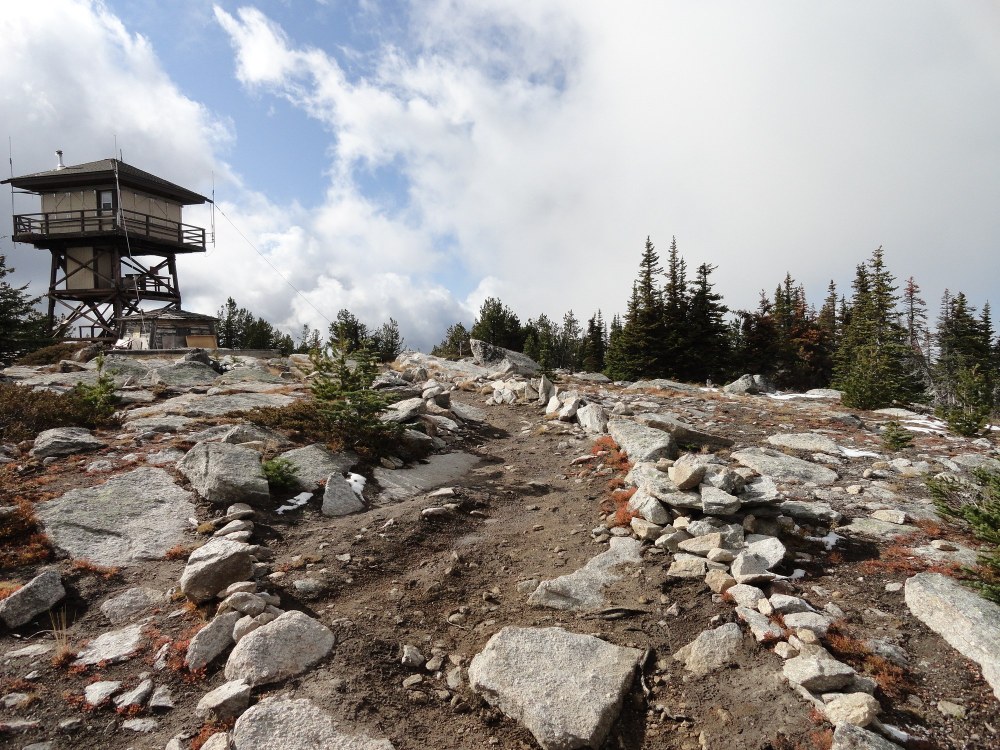
Eastern Washington’s third highest summit, 7,257-foot Mount Bonaparte rises all alone in the Okanogan Highlands. Bonaparte is a monadnock (also known as an inselberg) — a geological term taken from Mount Monadnock, a popular southern New Hampshire mountain memorialized by 19th century writers Ralph Waldo Emerson and Henry David Thoreau. The word monadnock is of Abenaki origin translating to isolated mountain. Monadnocks are lone isolated mountains standing above their surroundings. They have fared better than their environs in surviving the agents of erosion. Broad lofty Mount Bonaparte indeed stands alone, and with a 3,500-foot prominence, is distinguishable from quite a distance away.
An old and worn mountain in the eastern reaches of the Okanogan-Wenatchee National Forest, Bonaparte is quite different geologically than the Cascades to the west. Hike it and you’ll feel like you’re in another time zone. Not Mountain, Central, or Eastern — but Past. The first time I hiked this mountain was in 1990. I felt as if I had stepped back a century to the nascent days of the Forest Service. Could it have been because of the old and worn signs, the pine needle shrouded trail revealing a lack of other trail users, the old gnarled conifers shading the way, the views across the Okanogan Highlands revealing not one hint that the modern world was down below or anywhere near, or was it the fire lookout cabin constructed in 1914 that still graced this peak?
Bonaparte immediately occupied a special place in my heart. Bonaparte seemed immune from the chaos and maddening clutter of the modern world. A place I could return to where time stands still; a place I could restore my sanity and reset my compass. But when I returned in 2003, my heart was wrenched. The Forest Service had allowed a modern incursion on the mountain’s main trail — the use of ATVs. They were being used to transport supplies to the newer 1961-built fire lookout which is staffed every summer in a region where fire is as common as rain is in the Olympics. But with no oversight and a lack of rangers and other Forest Service personnel on the mountain and its trails, scores of off-road riders were now also ripping up and down the mountain. In less than a decade, the ATVs rendered what was a quiet historic century-old byway into an eroded, trenched, and dusty travesty; an eyesore. And with each passing motor, an assault on the tranquility of a natural sanctuary. No one in their right mind would now want to hike this trail. Why were the ATVs even contemplated by the Forest Service in the first place? Were horses no longer sufficient to pack supplies to the lookout? Must we always make way for modernity despite that the older ways were more in harmony with preservation and sanctity of place?
Through public disapproval and viewing the negative outcome firsthand, the Forest Service eventually closed the trail to unauthorized ATV use (although motorcycles are still free to buzz up and down this mountain in one of the last large roadless areas remaining in Eastern Washington). Scofflaws still occasionally tear up the tread, however, as enforcement of rules and policy is near impossible when the agency is running on a shoestring budget. Thankfully, I have since discovered two other ways up the mountain on trails that bear the tracks of footprints and hoof prints, not the mark of machines. The Southside and Antoine trails nicely recreate the experience I had in 1990 hiking up the mountain.
The 1914-built fire lookout cabin sitting on the summit still greets me and views from the new lookout still reveal a landscape below that could easily be from 1914. It was in that year that the Great War broke out in Europe, Mexico was in a revolution, and the Hetch Hetchy Dam was under construction about to inundate one of the greatest valleys in the American West. Political unrest, human conflict, and environmental destruction — one hundred years forward some things never change. It's the reason I keep returning to mountains like Bonaparte; mountains that are sanctuaries for my sanity. Places I can retreat to from the messes we humans have created in the past 10, 100, 1000 years. I want this old mountain to remain solid and embracing. I want this old monadnock to continue to have the same effect on me that the Mount Monadnock had on Emerson and Thoreau. ”On the tops of mountains, as everywhere to hopeful souls, it is always morning,” extolled Thoreau. I agree.
This article originally appeared in our Summer 2018 issue of Mountaineer Magazine. To view the original article in magazine form and read more stories from our publication, click here.
 Craig Romano
Craig Romano